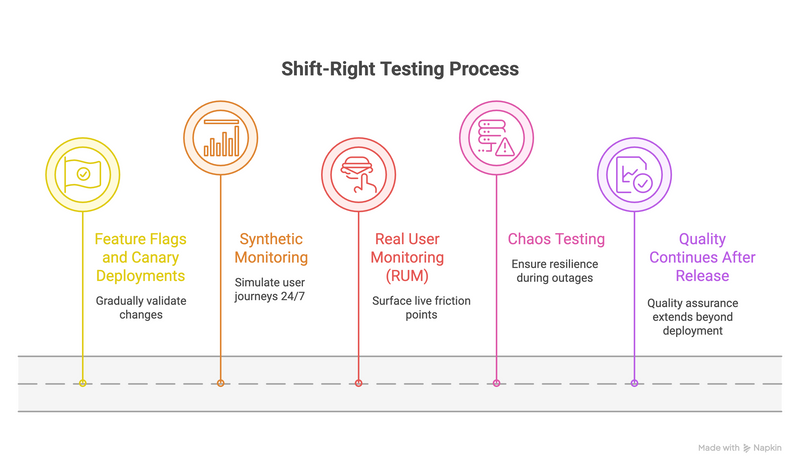In the race to automate everything, we’ve almost forgotten that quality is more than green checkmarks. It’s about trust. Usability. Delight. Revenue. And today, QA isn’t just about catching bugs—it’s about delivering value at every touchpoint.
While automation has transformed how QA works, the next big leap is redefining what QA means. As 2025 unfolds, we’re witnessing a profound shift: from script-driven testers to strategic quality engineers who collaborate across business, design, and development.
Let’s talk about what that looks like—and why now is the time to reimagine the QA function from the ground up.
From Gatekeepers to Business Partners
Traditional QA focused on defect counts, coverage percentages, and pass/fail rates. While important, these metrics miss what matters most: the user experience and business outcomes. A flawless release that frustrates users still fails.
Modern QA teams are redefining success by asking:
- Does the product feel intuitive to real users?
- Can our system handle production-level traffic and edge cases?
- Is accessibility baked in—not bolted on?
- Are we preventing churn, not just regression bugs?
This evolution reframes QA as a business-aligned partner, deeply connected to customer needs and product goals. In practice, it means testers are sitting in on roadmap meetings, asking hard questions during design reviews, and prioritizing what actually impacts the user—not just what’s easy to automate.
The Rise of Shift‑Right: Testing Where It Actually Matters
We’ve heard of “Shift‑Left”—testing earlier in the dev cycle. Now, leading QA teams are adding another vector: Shift‑Right, which means testing in production-like environments and capturing real-world signals.
Why?
Because users don’t care how many unit tests passed—they care whether the product works when they need it.
Shift‑Right testing includes:
- Feature flags and canary deployments to validate changes gradually
- Synthetic monitoring to simulate user journeys 24/7
- Real user monitoring (RUM) to surface live friction points
- Chaos testing to ensure resilience during outages
This isn’t about being reckless—it’s about being proactive. QA doesn’t end at deployment. In fact, quality continues after release. And that’s where the most valuable insights live.
Observability: A QA Superpower, Not Just a DevOps Concern
In the past, observability was a post-mortem tool—something engineers used when things went wrong. But now, forward-thinking QA teams are leveraging it before users report issues.
By instrumenting apps with logs, traces, and metrics early on, QA can:
- Catch memory leaks and performance dips during testing
- Detect API response inconsistencies
- Monitor error rates tied to specific releases
This Shift‑Left observability transforms QA into an insight engine—not just a checkpoint. It gives testers real-time visibility into how code behaves, helping them focus efforts where risk is highest.
And when combined with Shift‑Right tactics? QA gains a complete 360° view of quality—from design to production and back.
Quality as Experience: The Rise of Design-Driven QA
As software eats the world, user expectations rise. A laggy animation or unlabelled form field can cost users in seconds. QA can no longer ignore the subjective side of quality.
Design-driven QA is a growing movement that blends traditional testing with:
- UX validation: Can users complete key tasks easily?
- Accessibility audits: Is the experience inclusive for all?
- Cross-device usability: Does it work across form factors and screen readers?
This shift demands empathy. And empathy is something AI can’t yet replicate. QA engineers are now partnering with design teams, leveraging tools like Figma and Storybook, and even participating in user research.
When QA owns the feel of a product—not just its function—everyone wins.
Where Aurick Fits In: Quietly Empowering This New QA Era
As QA expands its scope, the challenge becomes focus. Time is still limited. That’s where AI-powered assistants like Aurick help—not by replacing QA, but by amplifying its impact.
Aurick works like an autonomous QA engineer that:
- Explores your app like a real user—no scripts needed
- Executes and heals test flows dynamically
- Surfaces bugs with full screenshots, logs, and reproduction steps
- Supports shift-right scenarios by validating real journeys in near-production environments
By offloading routine regression testing and exploratory coverage to Aurick, QA teams get space to focus on the higher-order work—strategy, design feedback, business alignment.
It’s not about removing humans from the loop. It’s about putting them back where they matter most.
Final Thoughts: QA’s Future Is Creative, Strategic, and Deeply Human
If automation was QA’s industrial revolution, this is its creative renaissance. We're entering an era where quality isn’t just about what works—but what feels right, performs at scale, and serves the business.
It’s a future where testers write fewer test cases and more strategy docs. Where they debug less and collaborate more. And where AI becomes the silent assistant, not the lead actor.
At the center of it all? QA engineers who think like designers, advocate like product managers, and build like developers.
Quality is no longer a gate. It’s a journey. And the best QA teams are leading the way.
Explore how Aurick helps QA teams go from test-driven to impact-driven.




Top comments (0)